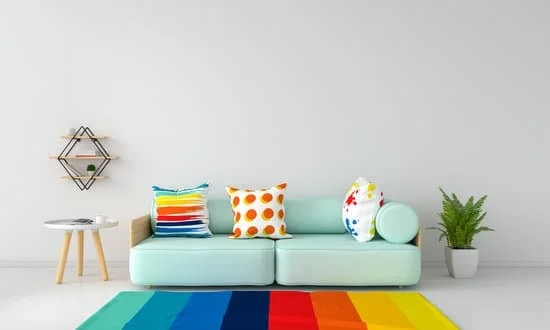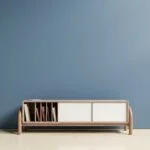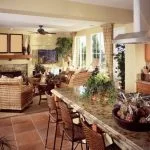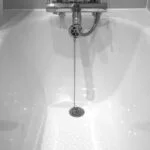Welcome to the future of home decor, where design trends and concepts are constantly evolving. As we settle into a new era, it’s important to stay ahead of the curve and anticipate what’s next in the world of interior design. This article will serve as your guide, exploring the cutting-edge ideas and innovations that are reshaping the way we think about decorating our homes.
In this rapidly changing landscape, it is crucial to understand the current trends that dominate the world of home decor. From sleek, minimalist designs to bold and eclectic styles, we will dive into the top design aesthetics of today. By examining these trends, we can better grasp how they have evolved and predict their influence on future concepts.
One key aspect of what’s next in home decor is the incorporation of technology. Smart home devices are revolutionizing how we interact with our living spaces, offering not only convenience but also added functionality. The integration of these devices is transforming traditional homes into intelligent environments that effortlessly blend style with innovation.
Stay tuned as we traverse through an array of exciting topics such as sustainable living practices, experimental use of colors and textures, mixing vintage elements with contemporary pieces, and incorporating multi-functional spaces. We will also explore the rise of personalized pieces and DIY projects as well as embrace nature through indoor gardens and biophilic design.
By embracing these progressive ideas and remaining open to change, we can create spaces that inspire us every day. So get ready to embark on a journey into the captivating world of home decor where endless possibilities await. Buckle up because together we will unravel what’s next in this thriving industry.
Current Trends in Home Decor
Modern Farmhouse
One of the top design styles currently dominating the home decor scene is modern farmhouse. This style takes inspiration from traditional farmhouse aesthetics and combines them with contemporary elements. The result is a warm and inviting space that exudes both comfort and sophistication. In modern farmhouse designs, you’ll often find exposed wooden beams, shiplap walls, barn doors, and vintage accessories mixed with sleek furniture and clean lines.
Scandinavian Minimalism
Another popular design style that has gained traction in recent years is Scandinavian minimalism. Characterized by its simplicity, functionality, and clean lines, this style creates an airy and clutter-free environment. Scandinavian interiors often feature light color palettes with pops of muted tones, natural materials like wood and leather, and an abundance of natural light. The goal of this style is to create a serene atmosphere where less is more.
Bohemian Eclectic
The bohemian eclectic style continues to be a favorite among those seeking a free-spirited and unique look for their homes. This style embraces vibrant colors, patterns, textures, and cultural influences from across the globe. Bohemian interiors often feature bold prints, layered textiles such as rugs and tapestries, handmade or vintage furniture pieces, and plenty of plants for an earthy touch. This design aesthetic encourages creativity and personal expression in decorating.
These three design styles represent just a fraction of the current trends in home decor today. However, they showcase how homeowners are embracing different looks to create spaces that reflect their individual tastes and preferences. As we move forward into the future of interior design, it will be interesting to see how these trends evolve or pave the way for new design approaches altogether.
Defining What’s Next
Modern interior design is a constantly evolving concept that reflects the changing tastes and preferences of homeowners. As we move into the future, it is important to explore and define what is next in this dynamic field. The concept of modern interior design has been influenced by various factors such as technology, sustainability, and lifestyle changes.
One of the key aspects of modern interior design is the use of clean lines and minimalism. This style focuses on simplicity and functionality, creating spaces that are sleek and uncluttered. However, as the concept evolves, there is a shift towards incorporating more warmth and personality into these minimalist spaces. Designers are now emphasizing the use of texture, color, and unique materials to add visual interest and create inviting interiors.
Another area where modern interior design is evolving is in its emphasis on creating healthy living environments. Biophilic design, which incorporates elements of nature into indoor spaces, has gained popularity as people recognize the benefits of being connected to nature within their homes. Indoor gardens, living walls, and natural materials like wood and stone are being used to bring nature indoors and create spaces that promote well-being.
In addition to these trends, customization has become a significant aspect of modern interior design. Homeowners are increasingly seeking personalized pieces that reflect their individual style and taste. DIY projects have also gained traction as people embrace the idea of creating unique pieces for their homes. This focus on customization allows individuals to make their homes truly their own and adds a sense of authenticity to modern interior design.
Overall, the evolving concept of modern interior design is embracing warmth, personality, sustainability, connectivity with nature, customization, and individuality. Designers are finding innovative ways to incorporate these elements into contemporary spaces while still maintaining functionality and simplicity. As technology advances and lifestyles continue to change, it will be fascinating to see how modern interior design continues to evolve in the future.
| Key Trends in Modern Interior Design | Examples |
|---|---|
| Use of texture and color | Incorporating unique materials like textured wallpapers, patterned rugs, and colorful accent pieces to add visual interest to minimalist spaces. |
| Biophilic design | Bringing nature indoors through the use of indoor gardens, living walls, and natural materials like wood and stone. |
| Customization | Offering personalized furniture pieces that reflect individual style and taste. Encouraging DIY projects to create unique items for the home. |
Incorporating Technology
As we move forward into the future, technology continues to play an increasingly prominent role in our daily lives. This influence is also extending into the realm of home decor, with smart home devices revolutionizing the way we interact with and shape our living spaces. From voice-controlled assistants to automated lighting systems, these devices are transforming not only the functionality of our homes but also the aesthetics.
One major aspect of incorporating technology into home decor is through smart lighting systems. With the rise of smart bulbs and fixtures, homeowners now have greater control over the ambiance and mood of their spaces.
These smart lighting solutions can be controlled remotely through mobile apps or voice commands, allowing users to adjust brightness, color temperature, and even create preset scenes for different activities or times of day. This level of customization provides a new layer of personalization in home decor that was not previously achievable.
Another exciting area where technology is shaping the future of decor is through the integration of smart appliances. From refrigerators that can create shopping lists to coffee makers that can be programmed remotely, these innovative devices make our homes more efficient and convenient. Incorporating such appliances into home design allows for seamless integration and a unified aesthetic throughout living spaces.
In addition to convenience and efficiency, smart home technology also offers enhanced security features. With the advent of advanced video doorbells, smart locks, and surveillance systems, homeowners can now monitor their property from anywhere using their smartphones or other connected devices. This not only provides peace of mind but also influences how spaces are designed and decorated to accommodate these equipment seamlessly.
Indeed, technology is continuously shaping the future landscape of home decor by introducing new possibilities for functionality, convenience, security, and aesthetics. As advancements in smart home devices continue to unfold, it is crucial for designers and homeowners alike to embrace this exploration and incorporate technological elements in a thoughtful manner that complements their overall interior design vision.
| Smart Home Tech | Impact on Home Decor |
|---|---|
| Smart lighting systems | Customizable ambiance and mood in every space |
| Smart appliances | Increased efficiency and convenience, seamless integration in design |
| Home security devices | Enhanced safety features, influence on space layout and aesthetics |
Sustainable Living
The global movement towards sustainability has not only influenced the fashion and food industries, but it has also made a significant impact in the world of home decor. As people become more conscious of their environmental footprint, they are seeking out eco-friendly materials and practices to revolutionize their living spaces. This shift towards sustainable living is transforming the way we decorate our homes and shaping the future of home decor.
One key aspect of sustainable home decor is the use of eco-friendly materials. Traditional materials such as wood and metal are being replaced with sustainable alternatives like bamboo, cork, and reclaimed wood. These materials are not only renewable but also have a lower carbon footprint compared to their traditional counterparts. Additionally, innovative materials such as recycled plastic, hemp, and organic cotton are being utilized in creating furniture upholstery, rugs, and curtains.
In addition to using eco-friendly materials, sustainable practices are also revolutionizing home decor. From energy-efficient lighting fixtures to water-saving plumbing systems, homeowners are incorporating environmentally conscious technologies into their spaces.
Smart thermostats that monitor and regulate energy usage, solar panels that generate clean energy, and rainwater harvesting systems that conserve water are just a few examples of how sustainability is taking center stage in home decor. By adopting these practices and technologies, homeowners can reduce their carbon footprint while still enjoying stylish and functional living spaces.
The rising popularity of sustainable living in home decor can be attributed to various reasons. Firstly, there is an increasing awareness about the impact of climate change and environmental degradation on our planet. People are realizing that making sustainable choices in their homes can contribute to a larger global effort towards reducing greenhouse gas emissions and conserving natural resources. Secondly, sustainable home decor offers unique aesthetic possibilities by embracing organic shapes, textures, and colors inspired by nature.
The use of natural elements creates a calming and soothing atmosphere that promotes well-being while adding visual interest to any space. Lastly, investing in sustainable products for your home does not have to break the bank. With a wide range of affordable and accessible options available in the market, homeowners can easily incorporate eco-friendly materials and practices into their decor without compromising on style or budget.
Maximalism vs. Minimalism
In the world of home decor, there has been a notable shift in decorating mindsets, from the dominance of minimalism to the rise of maximalism. Both styles have their own unique characteristics and appeal, and it’s important to understand how they are influencing the way we decorate our homes.
Maximalism: Maximalism is all about embracing abundance and expressing one’s personal style through bold colors, patterns, and textures. This design style is characterized by eclectic combinations of furniture and decor items that create a visually rich and highly individualized space. It encourages self-expression and allows homeowners to showcase their personality and interests through their home decor.
- Use vibrant colors: Maximalist spaces often feature vibrant colors like deep blues, rich reds, or bright yellows. These hues can be incorporated through statement pieces such as sofas, accent chairs, or large wall art.
- Mix patterns with confidence: Mixing different patterns is a key element of maximalism. Experimenting with various prints on upholstery, curtains, rugs, or throw pillows adds visual interest to the space.
- Showcase collections and mementos: Maximalist interiors provide an opportunity to display personal collections or sentimental objects. Shelves filled with books or curated gallery walls featuring photographs and artwork enhance the eclectic feel of the space.
Minimalism: While maximalism embraces excess, minimalism takes a more restrained approach by focusing on simplicity and functionality. Minimalist spaces are characterized by clean lines, neutral color palettes, and uncluttered surfaces. The goal is to create a calming atmosphere that promotes relaxation and mindfulness.
- Incorporate neutral tones: Neutral shades such as whites, greys, and beiges are the foundation of minimalist design. These colors create a sense of tranquility and help to visually enlarge small spaces.
- Declutter and organize: Minimalist spaces are known for their clutter-free environment. The emphasis is on keeping only essential items visible and neatly organized, utilizing storage solutions such as built-in cabinets or hidden storage furniture.
- Favor functional furniture: Furniture pieces in minimalist interiors are often sleek and multifunctional. Choose pieces with clean designs and simple shapes that serve a purpose without being overly decorative.
Ultimately, the shift from minimalism to maximalism reflects a broader movement towards personalization and self-expression in home decor. While some may prefer the simplicity and calmness of minimalism, others embrace the vibrancy and creativity of maximalism. Whichever side you lean towards, it’s important to create a space that truly resonates with your own unique style and personality.
Experimenting with Colors and Textures
In the ever-evolving world of home decor, one trend that continues to gain momentum is the experimentation with colors and textures. Gone are the days of muted neutrals and predictable patterns. Homeowners are now seeking bold, vibrant hues and rich textures to create spaces that truly reflect their personalities and make a statement.
One way to incorporate this trend is through the use of color blocking. This technique involves pairing two or more contrasting colors together in a bold, geometric manner. It can be applied to walls, furniture pieces, or even smaller accents like throw pillows or artwork. By embracing color blocking, individuals can add a sense of excitement and energy to their spaces.
Another popular method of pushing boundaries in home decor is by using unexpected textures. Incorporating different textures not only adds visual interest but also enhances the tactile experience of a room. For example, combining smooth surfaces with rough ones or adding cozy textiles like faux fur or velvet can create an inviting and layered look.
To further push the boundaries in home decor, mixing different patterns has become increasingly popular. The key here is finding patterns that complement each other rather than clash. Mixing stripes with floral prints, or polka dots with geometric designs, can create a dynamic and visually stimulating environment.
Mixing Old and New
In today’s ever-evolving landscape of home decor, one trend that is gaining popularity is the art of blending old and new elements. More and more homeowners are embracing the idea of incorporating vintage pieces alongside contemporary designs to create a unique aesthetic that feels both timeless and fresh. This fusion of old and new not only adds character to a space but also allows individuals to showcase their personal style and tell a story through their decor choices.
The Appeal of Vintage
Vintage pieces have an inherent charm that can instantly add character to any room. Whether it’s an antique chair with intricate detailing, a vintage rug with rich colors, or a retro lamp that brings back memories from another era, these pieces have the ability to bring history into our homes.
Many people are drawn to vintage items because they have stood the test of time, showcasing craftsmanship that is often unmatched in modern mass-produced products. By incorporating these pieces into our spaces, we pay homage to the past while creating a unique juxtaposition with contemporary elements.
Blending Vintage with Contemporary
The key to successfully blending vintage and contemporary elements lies in finding the right balance. A room filled entirely with vintage items may feel outdated or cluttered, while a space furnished solely with modern furniture might lack warmth and personality. The goal is to create harmony between the two styles by using contrasting textures, materials, colors, and shapes that complement each other.
For example, pairing a sleek modern sofa with a vintage coffee table can create an interesting focal point in a living room. Similarly, mixing old architectural features like exposed brick walls or distressed wood beams with clean-lined furniture can add depth and visual interest to any space.
Showcasing Personal Style
Blending vintage and contemporary elements allows individuals to showcase their personal style in an authentic way. It encourages creativity and allows for a more personalized approach to home decor.
Whether it’s incorporating family heirlooms, flea market finds, or one-of-a-kind statement pieces, this design trend allows homeowners to curate a space that reflects their individual tastes and tells a story. It adds depth and complexity to a room, creating an environment that feels curated over time rather than bought in one shopping trip.
As the world of home decor continues to evolve, the trend of mixing old and new elements is here to stay. By blending vintage pieces with contemporary design, individuals can create spaces that are both visually captivating and full of personal meaning. This approach allows for endless possibilities when it comes to telling unique stories through our homes and showcases how creativity can transform any space into something extraordinary.
Multi-Functional Spaces
As lifestyles and living situations continue to evolve, the concept of multi-functional spaces has gained significant traction in the world of home decor. In today’s fast-paced world, where space is often limited and versatile living is essential, creating rooms that serve multiple purposes has become a popular trend. This approach to design not only maximizes the usability of a space but also promotes efficiency and adaptability.
One key aspect of multi-functional spaces is their ability to adapt to changing needs. With more people working from home or engaging in hobbies that require dedicated areas, there is a growing demand for flexible spaces that can easily transform to accommodate different activities.
For example, a home office can double as a guest room with the addition of a sofa bed or a pull-out desk. Similarly, a dining area can be converted into an entertainment zone by incorporating smart furniture solutions like extendable tables or modular seating.
Utilizing space efficiently is another important consideration when designing multi-functional areas. Clever storage solutions such as built-in shelves, hidden cabinets, and multipurpose furniture are increasingly being incorporated into homes to maximize storage capacity without sacrificing style. Integrated organizational systems make it easier to keep clutter at bay and maintain an organized environment, enhancing the overall functionality of the space.
| Statistic | Data |
|---|---|
| Percentage of homeowners embracing open floor plans | 74% |
| Number of Americans working remotely at least part-time | 42 million |
| Percentage of households with limited square footage | 28% |
These figures highlight the growing need for adaptable and space-efficient solutions in home decor. Multi-functional spaces not only cater to changing lifestyles but also address the challenge of optimizing living areas in smaller homes or apartments.
Embracing Nature
Indoor gardens and biophilic design have become increasingly popular in home decor, as people are seeking to create a more natural and calming environment within their homes. This growing trend reflects a desire for a closer connection with nature, even in urban areas where outdoor space may be limited.
One way to incorporate indoor gardens into home decor is by creating vertical gardens. These can be installed on walls or hung from ceilings, utilizing space efficiently while also adding a touch of greenery to any room. Vertical gardens can be created using various techniques such as wall-mounted planters, moss panels, or even custom-built structures specifically designed for housing plants.
Biophilic design takes the concept of indoor gardens a step further by not only incorporating plants into the home but also integrating other elements of nature. This includes using natural materials like wood and stone, incorporating water features such as fountains or indoor ponds, and maximizing natural light through large windows or skylights.
In addition to the aesthetic benefits, indoor gardens and biophilic design also offer several health benefits. Studies have shown that being around nature can reduce stress and improve mood, as well as increase productivity and creativity. Indoor plants also act as natural air purifiers, filtering toxins from the air and improving overall indoor air quality.
As the popularity of indoor gardens and biophilic design continues to grow, there are now numerous resources available for those who want to start incorporating these elements into their own homes. From online tutorials to workshops and DIY kits, homeowners have plenty of options for embracing this trend and bringing a touch of nature indoors.
The Rise of Customization
In today’s fast-paced and mass-produced world, people are increasingly looking for ways to make their homes feel unique and personalized. This has led to a rise in the popularity of customization, with more and more individuals seeking out personalized pieces and DIY projects to adorn their living spaces. In this section, we will explore how the customization trend is taking center stage in home decor.
Personalized Pieces: Making a Home Truly Yours
One of the key aspects of customization in home decor is the desire for personalized pieces. From custom-made furniture to tailored artwork, people are craving items that reflect their individuality and tell their unique story. Personalized pieces not only add character and charm to a space but also create a sense of emotional connection, making a house truly feel like a home.
The demand for personalized pieces has given rise to several smaller businesses specializing in creating custom designs. Whether it’s a hand-painted sign with a family name or monogrammed throw pillows, these artisans are able to bring personal touches that big-box stores simply can’t provide.
Furthermore, advancements in technology have made it easier than ever for individuals to design their own customized pieces online, allowing them to choose colors, patterns, and even materials that align perfectly with their vision.
DIY Projects: Unleashing Creativity and Saving Money
Another aspect of the customization trend is the increasing popularity of DIY (do-it-yourself) projects in home decor. Thanks to social media platforms like Pinterest and YouTube tutorials, more people are discovering the joy of creating their own unique decor items. DIY projects offer individuals not only an outlet for creativity but also an opportunity to save money while adding personal flair to their homes.
From upcycling old furniture to repurposing everyday objects into decorative accents, DIY projects allow homeowners to unleash their imagination and customize their living spaces on a budget. Not only does this help reduce waste and promote sustainability, but it also gives individuals a sense of pride and accomplishment when they see their creations displayed in their homes.
Conclusion
In conclusion, the world of home decor is constantly evolving, with new trends and concepts emerging all the time. As we have explored in this article, there are several key factors shaping the future of home decor.
One of the most significant influences is technology. Smart home devices are becoming more integrated into our daily lives, allowing us to control various aspects of our homes with ease. From thermostats and lighting to security systems and entertainment centers, these technological advancements are not only convenient but also offer opportunities for innovative and futuristic design.
Another important aspect to consider is sustainability. With a growing focus on eco-friendly practices and materials, homeowners are increasingly seeking out environmentally conscious options for their decor. This shift towards sustainable living has paved the way for the use of renewable resources, recycling, and upcycling in home design.
Furthermore, the contrast between maximalism and minimalism has become a focal point in decorating mindsets. While some individuals prefer bold colors, patterns, and textures that make a statement, others opt for clean lines and simplicity. This dichotomy allows for personal expression while also reflecting changing aesthetics and preferences.
Additionally, embracing nature through biophilic design and incorporating indoor gardens is gaining momentum in home decor. The connection to nature not only enhances well-being but also adds an element of tranquility to any space.
Lastly, customization has become more prevalent as homeowners seek personalized pieces that reflect their individuality and style. DIY projects have gained popularity as people embrace their creativity while transforming their homes into unique spaces.
In light of these trends and concepts, it is crucial for individuals to stay informed about the ever-changing landscape of home decor. By being open to new ideas, incorporating technology, embracing sustainability efforts, experimenting with contrasting styles and colors, integrating natural elements, and adding personal touches through customization – one can create a living environment that reflects their personality while keeping up with the latest trends in home decor.
Frequently Asked Questions
What is out in decor 2023?
In 2023, the decor trends are moving away from heavily ornate and maximalist styles, as well as rustic and shabby-chic aesthetics that gained popularity in previous years. Instead, cleaner lines, minimalist designs, and a more streamlined approach to home decor are becoming prominent.
The focus is on simplicity and functionality, with an emphasis on creating spaces that feel open, airy, and clutter-free. Neutral color palettes such as whites, grays, and soft pastels are favored over bold and vibrant colors.
What is the next big thing in home decor?
The next big thing in home decor is the integration of sustainable and eco-friendly elements into interior design. With a growing awareness of environmental issues among consumers, there is an increasing demand for sustainable materials and practices in home decor.
This includes the use of organic fabrics, recycled materials, energy-efficient lighting solutions, low VOC paints, and furniture made from reclaimed or responsibly sourced wood. Additionally, incorporating indoor plants to improve air quality and create a connection with nature is also gaining popularity.
What is the most popular decorating style in 2023?
The most popular decorating style in 2023 is a blend of minimalism with warm textures and natural elements known as “warm minimalism.” This style combines the clean lines and simplicity of minimalism with cozy textures like faux fur throws or chunky knitted blankets. Natural elements such as wood accents or natural fibers are also incorporated to add warmth and a touch of nature indoors.
The color palette often consists of earthy tones like warm browns, muted greens, soft beiges combined with whites or light greys for a soothing atmosphere. This style provides a calming balance between simplicity and comfort while embracing nature-inspired elements.

I’m thrilled to be your companion on this exciting journey through the world of home decor and design. With a passion for turning houses into homes and a keen eye for the finer details, I’m here to help you transform your living spaces into beautiful, functional, and meaningful havens.





